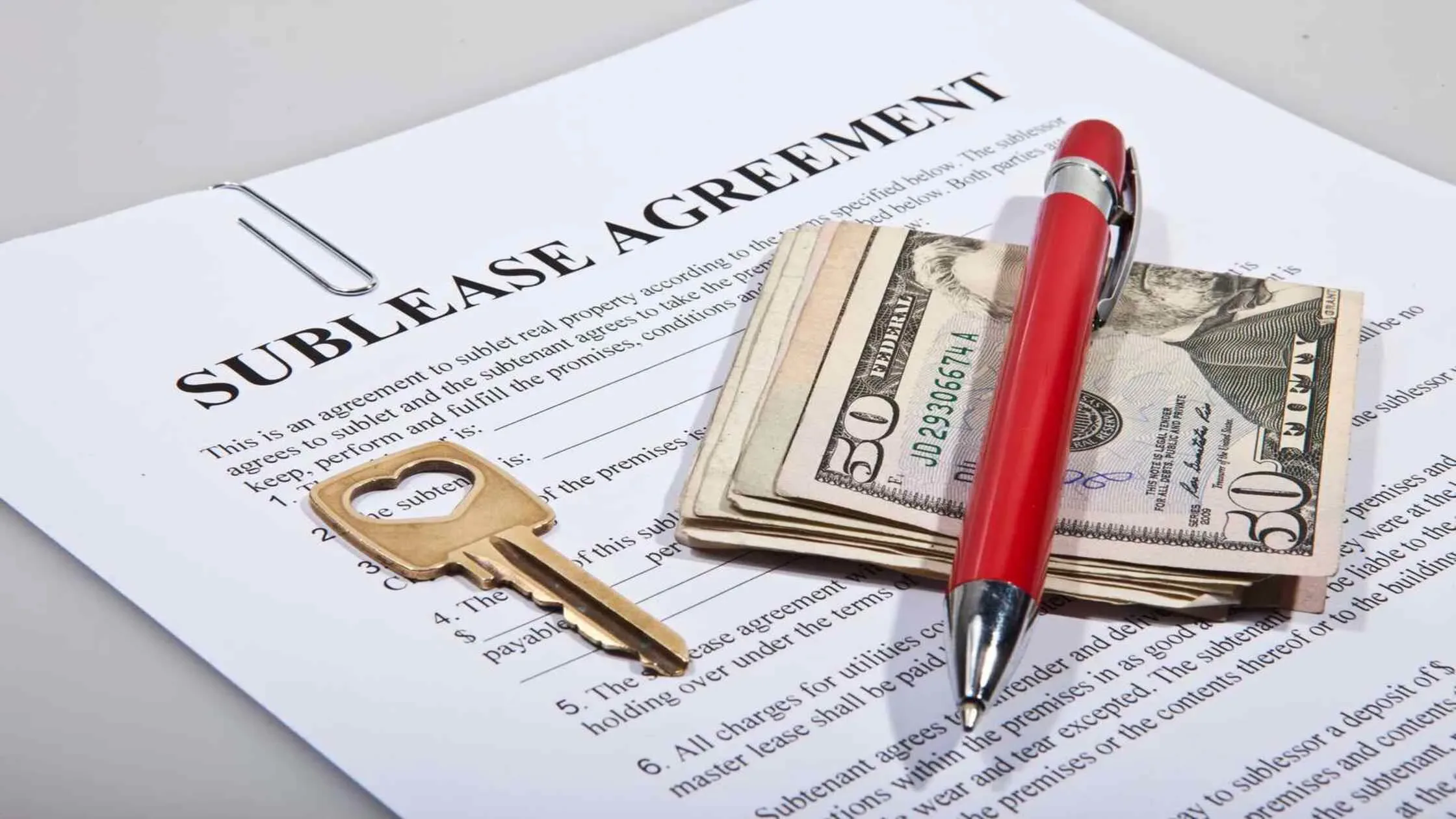Have you ever heard people say subletting and subleasing are the same thing? They’re not, and choosing the wrong one could cost you. This article will delve into the difference: subletting vs subleasing to help you understand before making a move!

What Is Subletting?
Subletting happens when a tenant temporarily hands over part or all of their rental to another person, while still holding onto the original lease. The tenant remains responsible for the space, even though someone else is living there. This can be as simple as a roommate agreement where you rent out a portion or whole space.
People often sublet for short-term absences, temporary relocations for work or school, or to ease financial burdens. Before subletting, written approval from the landlord is usually required to ensure compliance with lease contract rules and to avoid illegal sublets or eviction risk.
However, landlords typically require that tenants seek permission before subletting, and they may require approval of the subtenant to protect the property and ensure lease obligations are met. In short, subletting can bring more freedom and flexibility, but it comes with a healthy dose of responsibility.
What Is Subleasing?
A sublease is when the current tenant allows another person to rent the property, either in part or in full, while keeping the original lease active. Unlike subletting, subleasing can involve the entire unit being rented out to the subtenant, although the original tenant still holds the lease. The subtenant may pay rent directly to the landlord if stipulated in the new lease agreement.
Sublease also involves different legal and financial responsibilities depending on the lease terms, which makes it essential for tenants and landlords to review agreements carefully before proceeding.
Subleasing is ideal for longer-term arrangements, such as year-long relocations or extended work assignments. Tenant responsibilities and landlord obligations remain, and the sublease agreement must be clear to prevent disputes over rent, security deposits, or subtenant damages. Tenants may also refer to lease extension vs renewal options when considering longer-term agreements.
Because the original lease still governs the property, subleasing usually requires landlord approval and a clear written agreement. Without these safeguards, both the tenant and subtenant risk misunderstandings or legal disputes.
Subletting vs Subleasing: Key Differences
In casual conversation, people often use “sublet” and “sublease” as if they mean the same thing. But subletting vs subleasing isn’t just about semantics—it can impact rent payments, liability, and your relationship with the landlord.
Generally, subletting refers to renting out part of a property—such as a room—while the original tenant continues to live there. Subleasing, on the other hand, usually means transferring the entire rental to someone else for a set period, even though the original tenant still holds the primary lease.
Rent Payment Structure
With subletting, the subtenant typically pays rent directly to the original tenant, who then passes it along to the landlord. In subleasing, the setup can be similar, but some agreements allow the subtenant to pay the landlord directly. The key is that the landlord’s contract remains with the original tenant, so responsibility for timely payments never shifts away.
Responsibilities of Original Tenant
In both cases, the tenant remains bound by the lease. This is why understanding subletting vs subleasing is crucial—if a subtenant fails to pay or damages the unit, the landlord can still hold the tenant responsibilities..
Length of Agreement
Subletting works best for short-term arrangements, while subleasing is more common for year-long or full-unit transfers. When weighing subletting vs subleasing, consider how long you’ll be away and whether you’ll return.
Here’s a simple comparison:
Subletting is generally used for renting out part of a property, while subleasing is better for situations where the original tenant will be away for a longer period.
Situations When You Should Sublet or Sublease
Subletting or subleasing is a smart solution for tenants who need flexibility without breaking their original lease agreement. Here are three common scenarios where subleasing is an ideal choice.
You Need a Temporary Absence
This is one of the most common reasons to sublease. If you're going away for a long business trip, studying abroad, or caring for a family member, subletting allows you to avoid paying for an empty unit.
- Example: Rosie has a one-year lease in Boston. She gets a three-month summer internship in California. Rather than paying rent for an empty apartment all summer, she finds a suitable subtenant to cover her costs.
- Relevant Law: In some states, like California, landlords cannot "unreasonably" withhold consent for a sublease. Specifically, under California Civil Code § 1995.270, a landlord must have a legitimate reason to deny your request to sublease.
You Want to Rent Out Part of Your Property
If you live in a space that's larger than you need and want to ease your monthly financial burden, you can rent out an empty room. This is especially common among students or renters looking for a roommate.
- Example: Mark lives in a three-bedroom house in Austin, Texas. He uses one room as an office and another for storage. To cut down on living expenses, he decides to sublet the third bedroom to a friend. He still lives there and shares the common areas, while his friend pays him a monthly rent.
- Legal Note: While this is a common practice, you must check your original lease agreement. Many leases have a "no subletting" clause or require the landlord's consent before you can allow another person to reside in the property.
You're Trying to Avoid Breaking the Lease
Breaking a lease early can lead to severe financial penalties, including being held responsible for the entire remaining rent or losing your security deposit. Subleasing is a legal alternative that helps you avoid these penalties.
- Example: Emily has a 12-month lease in New York but gets an unexpected job offer in a new city just six months in. Instead of breaking her lease and facing a hefty fee, she finds a subtenant to take over the apartment for the remaining six months. The subtenant pays her, and she continues to pay the landlord, ensuring the lease is honored.
- Relevant Law: In many states, like New York, “breaking a lease" clauses are strict. However, subleasing can be considered a way to "mitigate damages" for both parties. According to the New York State government website, if your lease doesn't prohibit subleasing, you may be permitted to do so.
Lease Assignment vs. Subleasing/Subletting

Some tenants come across another term entirely when looking to transfer a rental: lease assignment.
Some tenants come across another term entirely when looking to transfer a rental: lease assignment.
Differences Between a Sublease and Lease Assignment
At first glance, a sublease and a lease assignment can look similar — both involve bringing a new person into the rental. But legally, they are very different.
- Sublease: The original tenant rents the property to a new occupant (the subtenant), while keeping the lease with the landlord active. The tenant remains legally responsible for rent and damages, even if the subtenant defaults.
- Lease Assignment: The tenant transfers all rights and obligations under the lease to a new tenant (the assignee). Once the landlord approves the assignment, the original tenant usually has no further responsibility.
Lease assignments are ideal for permanent moves, while subletting/subleasing suits temporary absences. Landlords may also require cash-for-keys agreements if terminating old tenants before re-leasing.
When to Use a Lease Assignment Over Subleasing
A lease assignment is often the better choice if you plan to leave permanently or have no intention of returning to the property. This way, you can transfer both the responsibilities and liabilities to someone else and close out your obligations with the landlord.
- Use a sublease when your absence is temporary, like a summer job, internship, or short relocation.
- Use a lease assignment when your absence is permanent, like moving to a different state, purchasing a home, or ending a long-term rental commitment early.
For example: Maria lands a new job across the country and buys a house. Instead of subleasing her apartment and remaining liable for potential issues, she negotiates a lease assignment with the landlord. Once approved, the new tenant takes full responsibility, freeing Maria from future financial or legal risks.
How to Sublet or Sublease: Step-by-Step Guide

For landlords, approving subletting vs subleasing requires careful evaluation. Reviewing the lease, screening new tenants, and drafting a clear agreement are essential steps. Here are the key steps to evaluate before giving approval.
Step 1: Review Your Lease Agreement
Start by carefully reviewing your existing lease. If your contract includes a “no subletting” clause, you have the right to deny requests outright. If it permits subletting or subleasing with written consent, look for any conditions you’ve outlined, such as notice periods, application fees, or required documentation. These details ensure you comply with the lease terms and avoid unexpected charges or delays when approving a subtenant.
Step 2: Notify Your Landlord
Ask tenants to submit a written request that details who the new occupant is, how long they’ll stay, and how rent will be paid. Some landlords also include an application process so they can screen the subtenant just as they would a new renter.
Tip for landlords: New York law requires tenants to send a written sublet request with specific details, and landlords must respond within 30 days. If they fail to do so, the request is automatically deemed approved. Knowing state timelines protects your rights.
Step 3: Create a Sublet/Sublease Agreement
Never rely on informal arrangements. Draft a formal agreement that covers tenant responsibilities, rent payment structure, security deposits, subtenant damages, and compliance with lease contract rules. This protects all parties and prevents disputes.
Step 4: Get the Right Signatures
Ensure that both the original tenant and subtenant sign the agreement, and that you, as landlord, also sign off on it. This makes expectations legally binding and preserves your authority over the property. Without your signature, enforcing terms against a subtenant can be more complicated.
Risks of Subletting or Subleasing Without Approval
Subletting vs subleasing without your landlord’s approval can violate your lease, trigger fines, or even lead to eviction.
Risks for Landlords
For landlords, an unauthorized sublet or sublease creates serious problems:
- Loss of control over occupants: Subletting vs subleasing both introduce third parties into your unit. Without approval, you have no chance to screen them for credit, rental history, or behavior. This could mean strangers living in your property without your knowledge.
- Potential lease violations: Unauthorized subtenants often bypass background or credit checks. This increases the risk of late payments, property misuse, or disruptive behavior.
- Difficulty enforcing lease terms: If a subtenant was never formally recognized, it’s harder to hold them accountable for damages or rule violations. You may end up chasing the original tenant for repairs or unpaid rent.
- Legal complications due to jurisdiction differences: Some states, like Texas (Property Code § 91.005), give landlords the right to restrict or deny subleasing unless expressly allowed in the lease. Approving occupants is both a legal right and a protective measure.
Risks for Tenants
Tenants who sublet or sublease without approval also face significant consequences:
- Lease termination or eviction risk: Most leases explicitly require landlord consent. Violating this clause can result in eviction or early termination of the lease.
- Financial liability: Even if the subtenant pays rent directly to you, you remain responsible to the landlord. If the subtenant damages the unit or stops paying, those costs come back to you.
- No legal protection: Without a formal agreement reviewed by the landlord, enforcing rent deadlines, damage repairs, or behavior standards against a subtenant is difficult.
- Credit and rental history risks: An eviction or breach of lease can appear on your rental record or credit report, making it harder to secure housing in the future.
Always obtain written approval to sublet to avoid these issues.
Final Thoughts
Understanding subletting vs subleasing ensures tenants and landlords avoid misunderstandings. Following the proper procedures, obtaining approvals, and documenting agreements protects all parties. Those on flexible terms may also consider month-to-month lease options for additional flexibility.
FAQs
Q1. What Does Subletting an Apartment Mean?
Subletting an apartment means that the tenant rents out all or part of their apartment to another person (called the subtenant), while still maintaining their original lease agreement with the landlord. The original tenant remains responsible for the lease terms, including rent payments and property care, even though the subtenant is living in the space.
Q2. Is a Sublease Agreement Legally Binding?
Yes, a sublease agreement is legally binding. Once both parties sign the agreement, it creates a contract with enforceable terms between the original tenant (sublessor) and the subtenant. However, the agreement must not violate the terms of the original lease, and the landlord’s approval may still be required depending on the lease conditions.
Q3. How Long Can You Sublet an Apartment?
The length of time you can sublet an apartment depends on the terms of your lease and the agreement you make with the subtenant. Some leases allow tenants to sublet for just a few months, often covering short-term needs like a summer internship, a semester abroad, or temporary travel plans. Other leases might allow longer sublets, even for the remainder of the lease term, especially if the tenant is relocating permanently but wants to avoid breaking the lease early.







